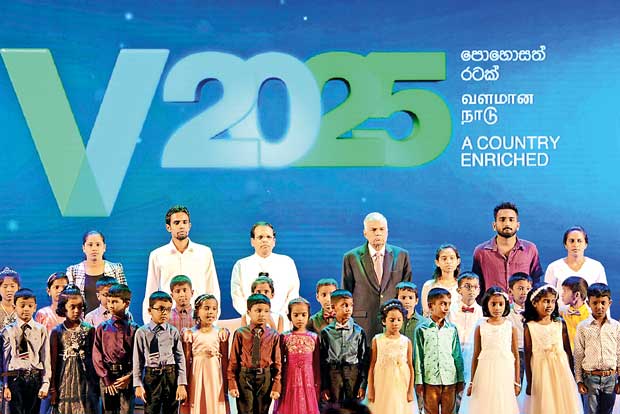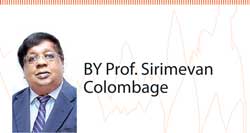18 Sep 2017 - {{hitsCtrl.values.hits}}
 President Maithripala Sirisena and Prime Minister Ranil Wickremesinghe at the ‘V2025: A Country Enriched’ launch
President Maithripala Sirisena and Prime Minister Ranil Wickremesinghe at the ‘V2025: A Country Enriched’ launch
 The government launched a new policy document titled ‘V2025: A Country Enriched’ early this month. The launching event seemed to have been designed to attract the youth with choreographic acts in an ultra-modern stage setting. The few youngsters who appeared along with the President and the Prime Minister on the stage posed questions to the two leaders.
The government launched a new policy document titled ‘V2025: A Country Enriched’ early this month. The launching event seemed to have been designed to attract the youth with choreographic acts in an ultra-modern stage setting. The few youngsters who appeared along with the President and the Prime Minister on the stage posed questions to the two leaders.
The V2025 document starts with the statement, “Our vision is to make Sri Lanka a rich country by 2025. We will do so by transforming Sri Lanka into the hub of the Indian Ocean, with a knowledge-based, highly competitive, social market economy”. This visionalong with the pledges that followed make the document impressive. Nevertheless, the feasibility of its ambitious targets needs to be considered in the context of the county’s political and economic realities.
Problems of implementation
This is the third policy document presented bythe government during the last two and half years. The Prime Minister presented the first two economic policy statements to the Parliament in November 2015 and October 2016. The contents of all these statements are more or less similar. Most of the proposals mentioned in the earlier two statements were not implemented. Had they been implemented, of course, the need for a third one would not have arisen. Releasing the same types of statements at short time intervals in this manner causes market uncertainty and confusion discouraging domestic and foreign investors.
The brief booklet, consisting of around 50 pages, has a long list of wish list to be fulfilled during the next 8 years. Surprisingly, it does not elaborate any specific policy strategies to be implemented to achieve the envisaged objectives. It also does not contain any statistical tables or charts which would have been useful to substantiate the facts behind
the Vision.
Macroeconomic vulnerabilities
Although strengthening the macroeconomic framework is cited as an important element in the document, no attempt seems to have been made to link the pledged progress with the macroeconomic setting, similar to the previous two statements. This is a common drawback that could be observed in the economic policies implemented in Sri Lanka in recent decades.
This contrasts with the development mechanism applied in the aftermath of economic liberalization in 1977. The National Planning Department of the then Ministry of Finance and Planning compiled the Public Investment Programme in collaboration with the relevantline Ministries. It was a kind of an indicative planning mechanism devised to go hand in hand with the free market economy so as to facilitate private sector activities.
Such macroeconomic framework ensured resource balances while carrying out the development plans. Of course, resource balancing was not fully achieved during the implementation stagesdue to the impending financing gaps in fiscal operations and balance of payments, and the resultant inflationary pressures. Nevertheless, the macroeconomic framework provided a safety valve to avoid aggravation of such imbalances. Eventually, the planning outfit of the Ministry of Finance disappeared some time agodue to changes in the government and for various other reasons. Economic policies and projects implemented without a sound macroeconomic framework usually end up with resource imbalances, inflation, debt accumulation and a host of other problems, as experienced in recent times.
Over-optimistic growth targets
The document states, “Over the next three years, within the 2025 Vision, we will implement a comprehensive economic strategy to address constraints to growth. We will aim to raise per capita income to US$ 5,000 per year, create one million jobs, increase FDI to US$ 5 billion per year and double exports to US$ 20 billion per year. These intermediate targets lay the foundation for our Vision 2025: Sri Lanka to become an upper-middle income country.”
At present, the country’s per capita income is around USD 4,000. In order to reach the projected per capita income of US$ 5,000, as envisaged in V2025, the GDP growth rate should be at least 8 percent a year in the next three years, compared with the growth rate of 4.4 realized last year and 4.7 percent estimated for this year. In other words, GDP growth rate should almost double from the present low growth trajectory.
The country will reach the upper-middle income category by 2025, according to the document. This means that per capita income should be over US$ 12,000 by that year implying a fourfold increase from the present level. In order to attain that target, GDP should grow by at least 15 percent annually during the next 8 years. This is more than a threefold increase ofthe present GDP growth rate which is running around 4.5 percent.
It is miraculous to expect such swift growth within a short time span of 3 - 8 years. The average GDP growth rate achieved throughout the last four decades following the liberalization of the economy in 1977 is only 5.1 percent a year. The country’s potential growth remains only around 4-5 percent. The reason is that Sri Lanka has failed to move from its traditional factor-driven growth model to technology-driven growth model, unlike the fast-growing East Asian economies. Hence, raising GDP growth to 8 percent as envisaged in the new document does not seem to be feasible.
More importantly, the GDP growth predictions implied in the Vision document are far above those can be found in the Staff Report of the International Monetary Fund (IMF) for the second review of the Extended Fund Facility concluded in June 2017. The annual growth projectionpresented in that report (compiled in consultation with the local authorities) for the period 2018-2021 is only 5.0 percent, which appears to be more realistic. If we use these figures, the maximum per capita income that could be reached in 2020 will be around US$ 4,600, which is lower than the level envisaged in the Vision.
Export projections are over-ambitious
Doubling of annual export earnings from the present level to US$ 20 billion, as expected in the V2025,will require an annual export growth of at least 25 percent. Again, it contradicts with the official projections given in the IMF report which forecasts an annual export growth of only around 5 years for the next four years.
It is illusive to expect doubling of export earnings, considering the dismal performance of the export sector in recent decades. Although industrial exports account for nearly 80 percent of total export earnings, Sri Lanka still depends on low value added, low-tech and labour intensive basic industries, mainly garments which account for almost one half of total export earnings. Other industrial exports consisting of food and beverages, rubber and leather products, machinery and transport equipment and petroleum products too are primary
level industries.
The East Asian countries, by contrast, phased out such primary industries decades ago and diversified their industrial structure towards high-tech products such as electronic and electric equipment, vehicles, computers, ships, medical apparatus, and optical and scientific equipment.
Given our traditional and static industrial structure, a miraculous growth in exports cannot be expected in the next few years. The much talked about achievements such as GSP+ or the planned free trade agreements like the Economic and Technical Cooperation Agreement (ETCA)with India can do very little to boost the export sector. The reason is that export constraints arise mainly from domestic factors rather than from limited market opportunities abroad.
Dwindling FDI inflows
Foreign direct investment (FDI) is expected to rise to US$ 5 billion per year during the next three years, according to the intermediate targets given in V2025. This seems to be a gross exaggeration, as the official projections given in the IMF report indicates FDI inflows of only around US$ 1 billion per year over the period 2018-2021.
06 Jan 2025 46 minute ago
06 Jan 2025 1 hours ago
06 Jan 2025 2 hours ago
06 Jan 2025 2 hours ago
06 Jan 2025 2 hours ago